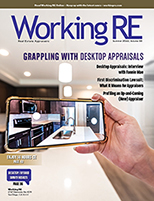 |
> RemoteVal
> OREP E&O |
If You Call a Dog’s Tail a Leg
by Hal Humphreys, Appraiser eLearning
There is a place in Spain, in the outer regions of the Basque country—that area surrounding Pamplona, where the coveted Hondarribia Zuri and Hondarribia Beltza grapes are crafted into Txakolina—with love and reverence. In this market, the farm dogs that guard the various livestock that occupy the spaces between vineyards are special. These Great Pyrenees are highly valuable and much sought after. In this region, the locals say, “El perro tiene cinco patas.”
The dog has five legs. You see, long ago, before the days of Cardinal Richelieu and the Spanish Inquisition, the plucky purveyors of pre-phylloxera vines were allotted land based on an unusual accounting of canine stock. The idea was that a farmer who had more dogs, obviously had more sheep, pigs, etc. This odd, regional, some would say colloquial, accounting system was simple, one hundred hectares of land per 20 legs. The supposition was a farmer could work a good solid 100 hectares with 5 dogs (4 legs per dog x 5 dogs = 20 legs).
This was all administered by the government of Spain and was strictly enforced. The regla de veinte patas, as it was known, was the law of the land for centuries. It, of course, ended when Franco came to power, but some of the more rural areas of the country still keep track of their dog-stock using the regla de viente patas.
Here’s where it gets interesting. In this notoriously obstinate region of Spain, the farmers petitioned a local monsignor to bless dog’s tails as an additional leg. Thus, “El perro tiene cinco patas,” the dog has five legs. You can see the benefits. Dogs with five legs would get you 100 hectares with four dogs instead of five. Call the tail a leg and you’ve got yourself a five-legged dog.
To this day, if one wants to buy a Great Pyrenees herding dog in the remotest regions of Basque country in Spain, the terms of the deal are based on five legs. It’s just how they do it. To be a dog breeder in this area one must have geographic competency. One must know that a dog’s tail is considered a fifth leg.
This story is pure fiction. It does, however, illustrate a point. Different markets accept different physical attributes as being relevant to valuation. In Humphreys County, Tennessee, lakefront lots are marketed based on water frontage. The size of the lot has little bearing on the valuation. That said, Fannie Mae still requires us to report the site size in their 1004 form.
(story continues below)
(story continues)
Below grade areas, what many of us call basements, are no different. In Perry County, TN a basement is considered just that, a basement. It may have a similar finish and may, possibly carry a similar weight in valuation, but they call it a basement. In the Crieve Hall neighborhood of Nashville, a basement is usually considered part of the Gross Living Area (GLA). Most of the homes have walkout basements that are of equal finish and value. Furthermore, they are marketed with the below grade area included in GLA.
ANSI requires us to articulate finished areas as above grade and below grade. There’s a good chance that the international canine association might require people in the Basque region of Spain to report a dog’s appendages accurately. If it’s a tail, call it a tail.
Does either change the value of property or dog?
No.
All the new ANSI standard is trying to do, is make sure we’re reporting the finished area as above grade or below grade. That’s it. Just report above grade and below grade finished areas as such.
If, in your market, like the Crieve Hall area of Nashville, people recognize below grade area as GLA, then address that in your sales comparison approach summary.
If I’m appraising a lakefront lot in Humphreys County, I’m going to report the site size on the 1004 form in the Site Analysis section. That’s what’s required. Then in my analysis, I’m going to point out to the reader that in this area, sites are valued based on water frontage.
The better analogy would be that dreaded second (or third) floor room with sloped ceilings. ANSI says for this area to qualify as finished area it must be at least five feet high and at least half of that must be seven feet or more.
In my market we’ve been valuing these second-floor rooms, regardless of the five-foot rule (“la pared tiene cinco pies.”), as finished area. Now, we’ll have to report finished area using the five-foot/seven-foot rule. Does that mean the remaining area has no value? No. It just means we can’t call a dog’s tail a leg anymore. Just explain that in your area the math is based on total square footage, not just the five/seven rule.
You may have to adjust in the grid or explain the difference in your analysis, but in reality, the new reporting does not impact our valuation analysis.
I realize that ANSI is new. It’s a change for some of us appraisers. Change can be difficult. That said, I think Fannie Mae is just trying to get everyone on the same page and have square footage be reported the same across the board. This in no way will impact valuation. You’ll still appraise properties as you always have. You’ll consider what the market participants are doing and you’ll apply the appropriate analysis to derive a market-based indication of value. That’s why you are so valuable, you provide the analysis to explain how the market is behaving.
I’m thinking of getting a dog. Our golden passed away several years ago. If you try to sell me a dog, I’d very much appreciate it if you called its tail a tail. Just so we’re on the same page.
About the Author
Hal Humphreys is a career-long real estate appraiser. He grew up measuring houses with his father, an appraiser. In the course of the past 30 years, Mr. Humphreys has appraised property across the country. He is a hearing officer for the Davidson County Board of Equalization. He has been a contract investigator/reviewer for the State of Tennessee Department of Commerce and Insurance. He also assists attorneys who represent citizens accused of crimes. Mr. Humphreys is partner in Appraiser eLearning and is the director of education for StoryboardEMP, llc, an education media company.
Tips for Smoother Appraising
CE Online – 7 Hours (45 states)
How to Support and Prove Your Adjustments
Presented by: Richard Hagar, SRA
Must-know business practices for all appraisers working today. Ensure proper support for your adjustments. Making defensible adjustments is the first step in becoming a “Tier One” appraiser, who earns more, enjoys the best assignments and suffers fewer snags and callbacks. Up your game, avoid time-consuming callbacks and earn approved CE today!
Sign Up Now! $119 (7 Hrs)
OREP Members: Save 10%
>Opt-In to Working RE Newsletters
>Shop Appraiser Insurance
>Shop Real Estate Agent
Insurance
Send your story submission/idea to the Editor:
isaac@orep.org




by Richard Hurtig
The problem with ANSI being a uniform standard for measurements is that Public Records and by extension, MLS and all other sources of data do not adhere to ANSI. Here in South Florida, PR has three different dimension disclosures (total, adjusted and living) and half the time, they are inaccurate. Townhouses and condominiums list the same disclosure for adjusted and living areas (adjusted area includes the GLA, 50% of a garage and 30 or 33% of other areas depending on how bad the records are, so we have to sift through this stuff and explain why there are discrepancies. Fannie wants to apply ANSI to all appraisals yet their “Collateral Underwriter” super duper secret database that they use to assess risk on appraisals is often pulling dimensions from Public Records and MLS. Rather than creating a uniform standard, this just compounds the problem and the default assumption, both with Fannie and with realtors and the public is that the appraiser did something wrong, so this means more time writing pointless addendums explaining why the GLA differs from whatever other bad data is out there. Meanwhile Fannie is complaining about appraisal costs and turn times, trying to shove “Desktop” appraisals down our throats…and asking for a floor plan which we are supposed to certify is reliable according to ANSI standards. Does this sound insane? It is because rather than addressing the need for a serious updating of appraisal forms eliminating pointless requirements, dealing with AMC fee theft and sharing the CU data with appraisers to expedite the process, Fannie is once again coming up with a surreptitious way to mine more data so they can do quick AVM’s and issue more appraisal wavers for their loans. The idea of a uniform standard for measurements is fine in principle but as usual, Fannie comes down with God like edicts without ever bothering to consult with appraisers who actually do the appraising.
-by Mike
I still think it is ludicrous to utilize a measurement system not utilized by the local assessor’s office. In the last 3 months I’ve delivered several reports where the subject is 1000+ sqft smaller than all the comps and they’re all model matches. It just means more explanation by the appraiser. For once I’d like to see a common sense change in the process, one developed by appraisers in the field. If I can do a desktop without using ANSI, then why am I using it in the first place? If I don’t need original comp photos for one form, why do I need them for any of the forms?
-by David
“All the new ANSI standard is trying to do, is make sure we’re reporting the finished area as above grade or below grade. That’s it. Just report above grade and below grade finished areas as such.” If ANSI and FNMA want conformity in reporting above and below grade living area why not provide a more detailed definition of below grade? I contacted FNMA and they were unable to provide a more detailed definition. This is especially true in areas where multi level homes built on slopes and entry is on the top floor with levels below. There are a number of ways the slopes can be retained and it’s not always readily visible. Do most appraisers understand exactly what is and isn’t below grade? I don’t think so when it comes to homes built on sloping lots where there is only slope to one side, toward the front of the home, with the sides and rear open.
-by David L Taylor
ANSI is wrong, dead wrong. So is everyone else who states that if any portion is below grade, you cannot include the entire area. Wrong, Wrong, Wrong. So you have a 40′ long wall with 1′ below grade. Laugh all you want, I did one like this. The county records included all the area, as would any potential buyer. ANSI needs to be changed. Who decided this in the first place? Why not just deduct that portion that is below grade?
-